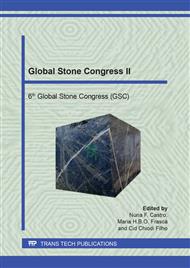[1]
J. E. Oti, J. M. Kinuthia, J. Bai, Unfired clay masonry bricks incorporating slate waste, Waste and Recourse Management. 163 (2010) 17-27.
DOI: 10.1680/warm.2010.163.1.17
Google Scholar
[2]
M. Frias, R. Vigil de la Villa, R. Garcia, I. de Soto, C. Medina, M. I. Sanchez de Rojas, Scientific and technical aspects of blended cement matrices containing activated slate wastes. 48 (2014) 19-25.
DOI: 10.1016/j.cemconcomp.2014.01.002
Google Scholar
[3]
L. B. Palhares. Estudo da estabilidade e comportamento de suspensões aquosas de pó de ardósia para aplicação em processamento cerâmico. Tese (Doutorado em Engenharia de Materiais), Ouro Preto, (2017).
Google Scholar
[4]
R. L. Bates and J. A. Jackson, Glossary of Geology, 3rd edn. Am. Geol. Inst, (1987).
Google Scholar
[5]
M. Campos, F. Velasco, M. A. Martinez, J. M. Torralba, Recovered slate waste as raw material for manufacturing sintered structural tiles, J. Eur. Cer. Soc 24 (2004) 811-819.
DOI: 10.1016/s0955-2219(03)00325-x
Google Scholar
[6]
G. Barluenga, F. Hernandez-Olivares, Self-levelling cement mortar containing grounded slate from quarrying waste. 24 (2010) 1601-1607.
DOI: 10.1016/j.conbuildmat.2010.02.033
Google Scholar
[7]
L.B. Palhares, H.S. Mansur, Production and characterization of ceramic pieces obtained by slip casting using powder wastes. J. Mat. Proc. Tech., 145 (2004) 14-20.
DOI: 10.1016/s0924-0136(03)00857-4
Google Scholar
[8]
C. Chiodi Filho, E. P. Rodrigues, A.C. Artur, Ardósias de Minas Gerais, Brasil: Características Geológicas, Petrográficas e Químicas. Rev. Geoc., 22 (2) (2003) 119-127.
Google Scholar
[9]
ABIROCHAS – Associação Brasileira da Indústria de Rochas Ornamentais. Estimativa da Serragem de Chapas de Rochas Ornamentais no Brasil. (2017).
DOI: 10.11606/d.18.2015.tde-16112015-092931
Google Scholar
[10]
L.B. Palhares, K. G. Dornas, G. de B. Praxedes, J. M. J. Sather, Development and Characterization of bricks using slate powder waste. In: X Brazilian MRS Meeting, Brazil, (2011).
Google Scholar
[11]
L.B. Palhares, H.S. Mansur, C. dos Santos, V. Oliveira, Microstructure evaluation of slate pieces submitted to heat treatment at different temperatures. In: 44th World Chemistry Congress, Istanbul, (2013).
Google Scholar
[12]
L. Catarino, et.al., Ceramic Products Obtained from Rock Wastes. J. Mat. Proc. Tech. 143-144 (2003) 843-845.
DOI: 10.1016/s0924-0136(03)00341-8
Google Scholar
[13]
L.E.F. Cambronero, J.M. Ruiz-Roman, J.M. Ruiz-Pietro, Obtentión de espumas a partir de resíduos de pizarra. Bol. de La Soc. Esp. Cer. y Vid., 44 (6) (2005) 368-372.
DOI: 10.3989/cyv.2005.v44.i6.330
Google Scholar
[14]
M.E.M.C. Silva, A.E.C. Peres, Thermal expansion of slate wastes. Min. Eng. 19 (2006) 518-520.
DOI: 10.1016/j.mineng.2005.10.008
Google Scholar
[15]
J.E. Oti, J. M. Kinuthia, J. Bai, D. G. Snelson, Applications of slate waste material in the UK, Waste and Recourse Management. 163 (2010) 19-15.
DOI: 10.1680/warm.2010.163.1.9
Google Scholar
[16]
M. Dondi, et.al. Lightweight aggregates from waste materials: Reappraisal of expansion behavior and prediction schemes for bloating. Cons. Buil. Mat. 127 (1016) 394-409.
DOI: 10.1016/j.conbuildmat.2016.09.111
Google Scholar
[17]
L. Zhen, et.al. Manufacturing of ultra-light ceramsite from slate wastes in Shangri-la, China. J. of the Kor. Cer. Soc. 55 (2018) 36-43.
DOI: 10.4191/kcers.2018.55.1.02
Google Scholar
[18]
M.T. Vieira, et.al., Optimization of the sintering process of raw material wastes. J. Mat. Proc. Tech., 92-93 (1999) 97-101.
Google Scholar
[19]
P.L. et.al., Reactividad álcali-sílice y álcali-silicato en pizarras. Est. Geol., 66 (2010) 91-98.
DOI: 10.3989/egeol.40143.094
Google Scholar
[20]
C.Ward, F. Gomez-Fernandez, Quantitative mineralogical analysis of spanish roofing slates using the Rietveld method and X-ray powder diffration data. E. J. Of Mineralogy, 15 (2003) 1051-1062.
DOI: 10.1127/0935-1221/2003/0015-1051
Google Scholar


